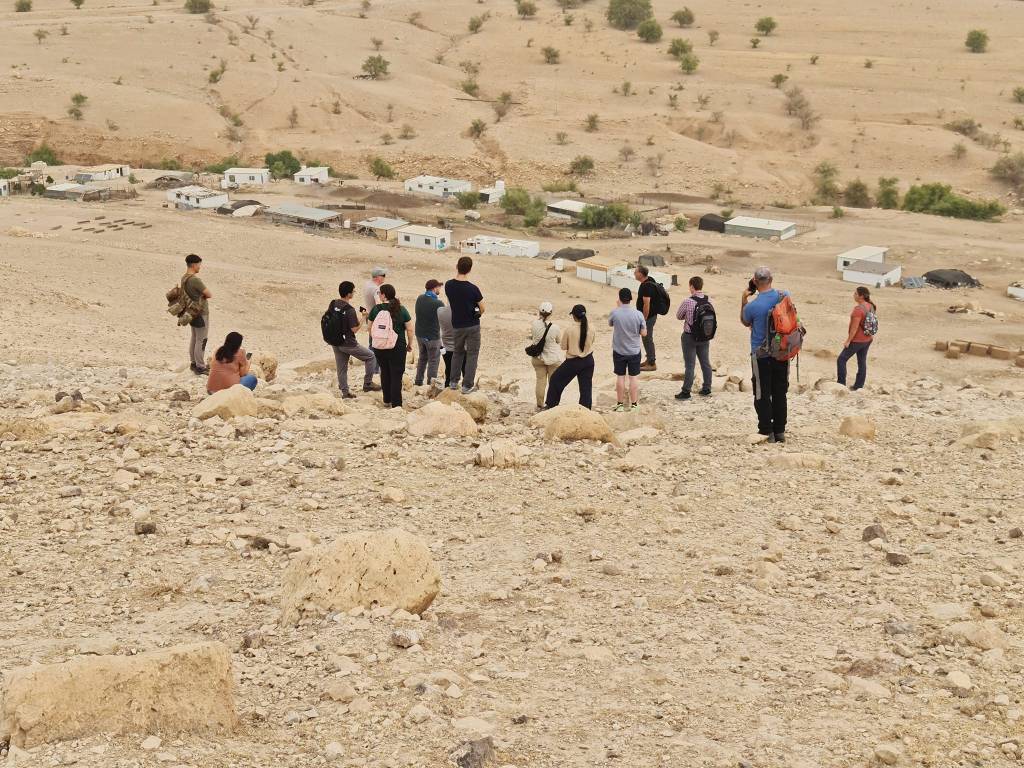This week I attended and participated in an archaeology conference at Ariel University. The theme of the conference was Boundaries and Influences in the Archaeology of Israel and the Eastern Mediterranean. Both local and international archaeologists attended the conference, and the presentations provided a glimpse into the most up-to-date research in a variety of aspects of archaeological studies.
I was one of the presenters at the conference. My presentation was on “Defining the Borders of a Marginal Zone: The Israel Central Hill Country during the Late Bronze/Iron I Transition.”
The multi-day conference included both presentations at the university and a day of touring archaeological sites. I enjoyed both aspects immensely.
Here are brief descriptions of a few of the lectures that I particularly enjoyed:
- “Boundaries in Time at the Bronze and Iron Age Transition: Collapse or Critical Juncture?”
- By Dr. Jesse Michael Millek.
- Dr. Millek suggested that the word collapse may not be ideal in describing the end of the Late Bronze Age. Instead, various sites experienced critical junctures at this point in their history. I found this lecture to be particularly helpful for my PhD research, since Dr. Millek has focussed his research on the Late Bronze Age/Iron Age I transitional period, which is also the focal point of my research.
- “On the Margin – The Survey of Palestine and the Historical Geography of the Shephelah”
- By Dr. Chris McKinny
- Dr. McKinny discussed the contribution of the Survey of Palestine maps in locating the border cities listed in the book of Joshua. Using the Arabic site names listed in the Survey of Palestine, he was able to trace the borders of the Israelite districts in the Judean Shephelah.
- “Digital Photography: advances in the CEDAR project and strategies for difficult cases”
- By Dr. Sarah Yardney
- Dr. Yardney’s research focusses on the Dead Sea Scrolls. She demonstrated the digital photography tools that they use in studying the scrolls. She showed us how they have digitally isolated every letter and word in the Samuel scrolls so that in cases where there is a damaged word, they can compare the visible parts of any given letter to any other given letter by overlaying the good letter directly over the damaged letter to see if it matches. This way, they are using that particular scribe’s own handwriting samples to recreate damaged text.
- “Invisible Borders – Evidence for ‘Sea Peoples’ in the Jordan Valley?”
- Dr. Katja Hoennecken
- Dr. Hoennecken presented the findings at Tall Zira’a in the Transjordan, comparing them with artifacts typically attributed to the Philistines. This presentation was very interesting to me because it dealt with the Late Bronze Age/Iron Age I transition in a region near to my research area.
- “Fingerprints on Canaanite and Judahite Pottery from Tel Burna: The Division of Labour and Demographics of Producers”
- Dr. Jon Ross
- Dr. Ross presented his current research on ancient fingerprints on pottery. He has analyzed the fingerprints on a variety of vessels and figurines from the Late Bronze Age and the Iron Age II. He was able to determine the age range and gender of each potter.
Field Trip

The final day of the conference consisted of a field trip. We started at Ariel and set out in a bus. It had rained that morning – the first rain of the season – and the air was clear and refreshing.
Our first stop was at Khirbet ‘Auja el-Foqa in the Jordan Valley. I was familiar with the site, since I have excavated there twice, but I enjoyed the tour regardless. There is a steep hike up to the site, but thanks to the morning rain and the cooler weather, it was quite pleasant. You can read about my past adventures at Khirbet ‘Auja here, here, and here.

We next headed back up to the hill country for a visit to Site E.P. 914. I had never been to this site, and it was one of the main reasons I had joined the tour. E.P. 914 is just north of Khirbet el-Maqatir, where I used to excavate. Aharon Tavgar, who excavated at E.P 914 believes that it is the ancient high place of Bethel where Jeroboam set up a golden calf.

After leaving E.P. 914, we had a very nice lunch in nearby Givat HarEl. Then, we paid a visit to Khirbet Rafid. I was familiar with the site, since I was part of the excavation there last year. I am looking forward to the next excavation season there! You can read about last year’s excavation at Khirbet Rafid here and here.
The tour had planned to also visit Tel Tibneh, but we ran out of time, so after visiting Khirbet Rafid we headed back to Ariel.


4 responses to “Boundaries and Influences”
Thank you for sharing!
LikeLike
Thanks for another interesting blog!
LikeLike
Congratulations, Abigail, on being a presenter at the archaeological conference! Thanks for the good report and pictures. It was very interesting to learn how digital photography could help reconstruct letters in damaged Hebrew texts!
LikeLike
Thanks for your update!
LikeLike